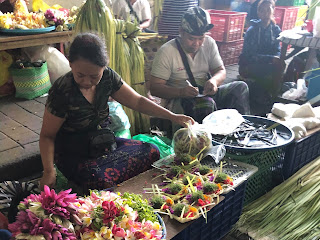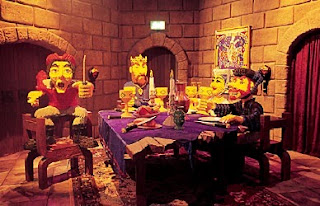Flowers of Bali - Ubud market
A few years ago, before Netflix, HBO Go and all the other streaming
services, before I started writing about food, I used to watch Andrew
Zimmern's show about strange types of food. And while there are still
many things I would never eat, I can honestly say that I dreamt of
seeing an exotic market for many years.
I arrived in Bali eager to smell and taste all the exotic fruit the rainy season of the island had to offer. Naturally, I was fascinated by jackfruit and especially durian, for these were the types of fruit I had never experienced before. I had watched all kinds of YouTube videos about durian, but I still had no idea what to expect. I experienced the smell on the very first evening after arriving, when I was still getting used to the humidity and the heat. I entered a supermarket to buy water and there it was, a spiked, green, medium-sized fruit, which oozed a rotten smell, which was so strong it was hard for me to stand near it.
The next day, I saw the huge durian tree growing just outside the terrace where I had breakfast. The terrace looked upon the jungle, which dropped several tens of meters below it, and the durian tree, full of ripe fruit, grew tall above us. From the distance, the smell of the fruit was thankfully enclosed in the hard, spiked shell. I visited the Ubud art market that day, ready for its Asian feel, for the explosion of color and sound, for the sheer overwhelming volume of artifacts, for the crumbling walls of the grey concrete buildings and, of course, for the never-ending negotiations. I think the feeling of an Asian tourist market is something everyone should experience, at least once. It's unnerving and exhilarating at the same time.
But the art market in Ubud is not what I want to write about. The sarongs, the statues, the beaded accessories, the incense smells, all appealed to the bookworm in me. But I knew that the market had another face, one that was not dedicated to tourists. The "real" market, as I felt it, took place in the same spot, in a sort of square with winding roads and stairs, just outside the ancient royal palace of Ubud. The vegetable and flower vendors came in the morning, from 6 A.M to 8 A.M. A modest entrance hid the vastness of the market, which sprawled along several streets and ended in a square dent, from which you could only go up the stairs. In the art market, the vendors had shops with tables placed outside to attract customers. In the fruit and flower market, the merchandise was placed in baskets on the ground, on large sheets of plastic. There were so many vendors and customers, such a swirl of smells, sounds, and colors that it could make you dizzy just by walking among them.
I never was a morning person, but thanks to the jetlag and the proximity of the jungle, in Ubud I woke up easily at 5 A.M, before sunrise. The jungle sunrise is one of the most spectacular things I have ever experienced because you can hear every living creature waking up and somehow saying "hi" to the sun. No sunrise I have ever seen (including the forest ones, which I love, or the sun rising from the sea) beats that.
At 6.30 A.M I was in the fruit and flower market. I keep calling it a flower market because I have never seen anything like it. The Balinese have ritual offerings (blog post about them here http://corinagruberstory.blogspot.com/2020/01/bali-peace-offerings.html) and, in addition to selling the actual offerings, women also sell flowers, which represent an important source of income for the locals on the island. Stemming from the words of Krishna in the Bhagavad Gita, flowers are regarded as suitable offerings to gods in Balinese culture. Also, they represent beauty, fragrance, and spirituality. Apart from the canang sari, flowers are used to adorn religious statues and temples (which exist in every household). More recently, because of the proliferation of spas, flowers are used for flower baths or for filling entire pools. In the market, flowers are sold in heaps, by the kilo. A Balinese family uses about half a kilo of petals a week for the canang sari. It's hard to describe the image of the mountains of flowers and petals. According to Hindu tradition, most flowers used are red, white, magenta, yellow, and orange. Each color represents a different god and has a different symbolism. This symbolism runs so deep, that it connects not only the color to the god and a general meaning, but to cardinal points, human organs, forms of landscape, and general philosophical principles.
Frankly, it's difficult for me, having lived in Western society for my entire life (although my country is East- European) to wrap my head around all the meanings of flowers, smells or fruit in Balinese culture. The market was an overwhelming experience, but not in a negative sense. It's just so much to look at and to experience. And you can choose to do as I did while there, simply look and register the unbelievable calmness of it all, or you can choose to try and understand some 3000 years of spirituality (at which point you'll probably feel your head explode, as I do now).
So, back to the flowers... I think I circled the market for about half an hour, trying not to stare as if coming from another world. I wanted to capture everything, from the look of the flowers in huge baskets, hid in semi-darkness, to the serene faces of women weaving baskets for canang sari right there in the market. Don't get me wrong: the smell of flowers was drowned by the strong scents of mixed fruit and vegetables. But they still captured the eye. In the end, I bought a kilo of bougainvillea mixed colored flowers and half a kilo of marigold. And I used them to fill the bathtub.
While I am still on the subject of Balinese flowers, there are two others, which are very powerful symbols, not sold in the market. One is frangipani, one of the most complex flowers I have ever seen, and the other is the red hibiscus flower. Frangipani is white, yellow or pink and it grows on trees, in bunches. The flowers have a sweet, deep, and intoxicating scent and a soft, rubbery texture. They are not plucked, but fall from the trees and people pick them up, use them in prayer and worship, and wear them behind their ear (both men and women - I even saw a security guard, in uniform, wearing one). They represent purity and goodness. Red hibiscus blooms in large flowers in Bali, and it symbolizes power.
I set out to write a blog post about the Ubud market and wound up writing about flowers. After all, it figures...they were the first thing I saw as I entered the market: huge, colorful, soft mountains of petals. I'll write another post about the fruit in the market and about how I tried durian.







